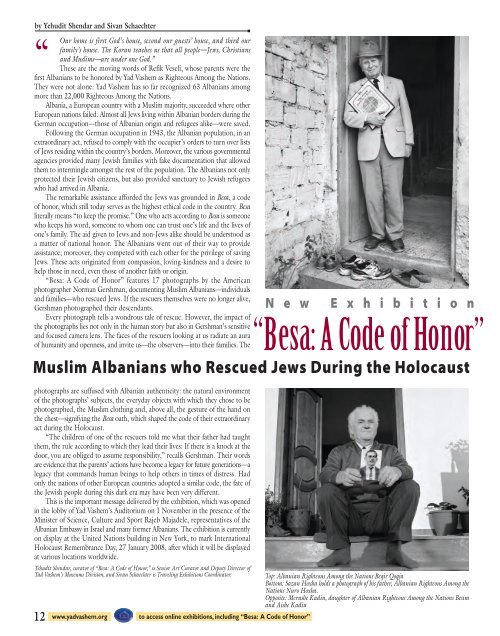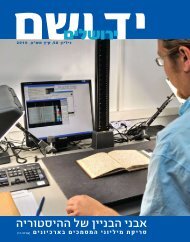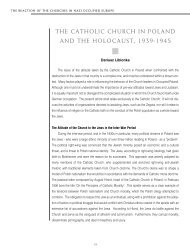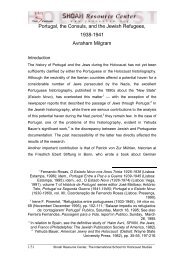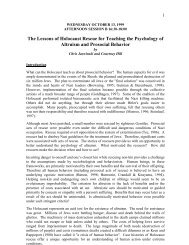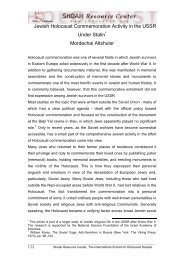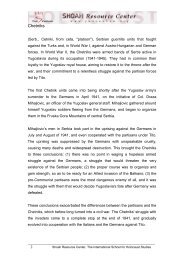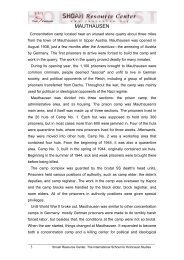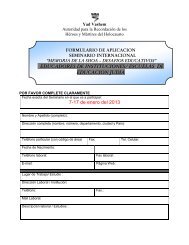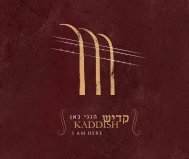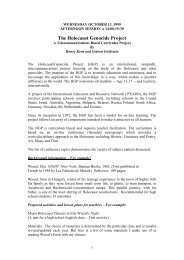Magazine 48 - Winter 2008 - Yad Vashem
Magazine 48 - Winter 2008 - Yad Vashem
Magazine 48 - Winter 2008 - Yad Vashem
You also want an ePaper? Increase the reach of your titles
YUMPU automatically turns print PDFs into web optimized ePapers that Google loves.
“by Yehudit Shendar and Sivan Schaechter<br />
Our home is first God’s house, second our guests’ house, and third our<br />
family’s house. The Koran teaches us that all people—Jews, Christians<br />
and Muslims—are under one God.”<br />
These are the moving words of Refik Veseli, whose parents were the<br />
first Albanians to be honored by <strong>Yad</strong> <strong>Vashem</strong> as Righteous Among the Nations.<br />
They were not alone: <strong>Yad</strong> <strong>Vashem</strong> has so far recognized 63 Albanians among<br />
more than 22,000 Righteous Among the Nations.<br />
Albania, a European country with a Muslim majority, succeeded where other<br />
European nations failed. Almost all Jews living within Albanian borders during the<br />
German occupation—those of Albanian origin and refugees alike—were saved.<br />
Following the German occupation in 1943, the Albanian population, in an<br />
extraordinary act, refused to comply with the occupier’s orders to turn over lists<br />
of Jews residing within the country’s borders. Moreover, the various governmental<br />
agencies provided many Jewish families with fake documentation that allowed<br />
them to intermingle amongst the rest of the population. The Albanians not only<br />
protected their Jewish citizens, but also provided sanctuary to Jewish refugees<br />
who had arrived in Albania.<br />
The remarkable assistance afforded the Jews was grounded in Besa, a code<br />
of honor, which still today serves as the highest ethical code in the country. Besa<br />
literally means “to keep the promise.” One who acts according to Besa is someone<br />
who keeps his word, someone to whom one can trust one’s life and the lives of<br />
one’s family. The aid given to Jews and non-Jews alike should be understood as<br />
a matter of national honor. The Albanians went out of their way to provide<br />
assistance; moreover, they competed with each other for the privilege of saving<br />
Jews. These acts originated from compassion, loving-kindness and a desire to<br />
help those in need, even those of another faith or origin.<br />
“Besa: A Code of Honor” features 17 photographs by the American<br />
photographer Norman Gershman, documenting Muslim Albanians—individuals<br />
and families—who rescued Jews. If the rescuers themselves were no longer alive,<br />
Gershman photographed their descendants.<br />
Every photograph tells a wondrous tale of rescue. However, the impact of<br />
the photographs lies not only in the human story but also in Gershman’s sensitive<br />
and focused camera lens. The faces of the rescuers looking at us radiate an aura<br />
of humanity and openness, and invite us—the observers—into their families. The<br />
photographs are suffused with Albanian authenticity: the natural environment<br />
of the photographs’ subjects, the everyday objects with which they chose to be<br />
photographed, the Muslim clothing and, above all, the gesture of the hand on<br />
the chest—signifying the Besa oath, which shaped the code of their extraordinary<br />
act during the Holocaust.<br />
“The children of one of the rescuers told me what their father had taught<br />
them, the rule according to which they lead their lives: If there is a knock at the<br />
door, you are obliged to assume responsibility,” recalls Gershman. Their words<br />
are evidence that the parents’ actions have become a legacy for future generations—a<br />
legacy that commands human beings to help others in times of distress. Had<br />
only the nations of other European countries adopted a similar code, the fate of<br />
the Jewish people during this dark era may have been very different.<br />
This is the important message delivered by the exhibition, which was opened<br />
in the lobby of <strong>Yad</strong> <strong>Vashem</strong>’s Auditorium on 1 November in the presence of the<br />
Minister of Science, Culture and Sport Rajeb Majadele, representatives of the<br />
Albanian Embassy in Israel and many former Albanians. The exhibition is currently<br />
on display at the United Nations building in New York, to mark International<br />
Holocaust Remembrance Day, 27 January <strong>2008</strong>, after which it will be displayed<br />
at various locations worldwide.<br />
Yehudit Shendar, curator of “Besa: A Code of Honor,” is Senior Art Curator and Deputy Director of<br />
<strong>Yad</strong> <strong>Vashem</strong>’s Museums Division, and Sivan Schaechter is Traveling Exhibitions Coordinator.<br />
12 www.yadvashem.org to access online exhibitions, including “Besa: A Code of Honor”<br />
N e w E x h i b i t i o n<br />
“Besa: A Code of Honor”<br />
Muslim Albanians who Rescued Jews During the Holocaust<br />
Top: Albanian Righteous Among the Nations Beqir Qoqja<br />
Bottom: Sazan Hoxha holds a photograph of his father, Albanian Righteous Among the<br />
Nations Nuro Hoxha.<br />
Opposite: Merushe Kadiu, daughter of Albanian Righteous Among the Nations Besim<br />
and Aishe Kadiu


